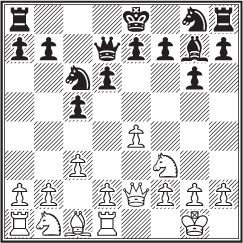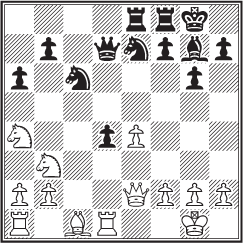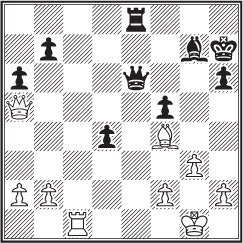
Fischer made a deep impression on Boris Spassky and David Bronstein when they met him at Mar del Plata 1960. They were struck by his strong opinions – such as predicting that Mikhail Botvinnik would easily defeat Tal in the world championship match about to begin in Moscow. They were also struck by his energy: After losing to Spassky in the second round, the American allowed only one draw in the remaining 13 rounds.
Fischer – Fridrik Olafsson
Mar del Plata 1960
Sicilian Defense, 3 ♗b5+ Variation (B51)
1 |
e4 |
c5 |
2 |
♘f3 |
d6 |
3 |
♗b5+ |
|
The first – and only – time Fischer tried this in a serious game.
3 |
... |
♗d7 |
4 |
♗xd7+ |
♕xd7 |
5 |
0–0 |
♘c6 |
6 |
♕e2 |
|
Nicolas Rossolimo had popularized the logical plan of ♕e2/♖d1 and d2-d4 in the 1950s. White will decide on whether to play c2-c3 based on Black’s next move or two. For example, on 6...e6 he goes directly to 7 ♖d1 and 8 d4 to exert pressure against d6.
6 |
... |
g6 |
7 |
c3 |
♗g7 |
8 |
♖d1 |
|

8 |
... |
e5 |
Fischer’s classical approach was illustrated in the post-mortem: Spassky and Bronstein suggested 8...f5, to regain control of d5, Spassky later gave 9 exf5 ♕xf5 10 d4 cxd4 11 cxd4 ♘f6 and ...♘d5 as a possible continuation. But Fischer dismissed 8...f5 out of hand. Olafsson’s choice makes d2-d4 essential, since otherwise Black can build a potent initiative with ...0-0, ...♖ae8 and ...f5-f4.
9 |
♘a3 |
|
Rossolimo played 9 d4 against Fischer two years later in the U.S. Championship and obtained enough play for the pawn after 9...exd4 10 cxd4 ♘xd4 11 ♘xd4 cxd4 12 ♘a3 ♘e7 13 ♘b5 ♘c6 14 ♗f4 ♗e5 14 ♗f4 ♗e5 15 ♗h6 0–0–0 16 f4! (This transposes into a line Spassky considered as insufficient compensation for White after 16 ♖ac1 ♔b8 17 b4).
9 |
... |
♘ge7 |
10 |
d4! |
cxd4! |
White can favorably exploit the d5 hole after 10...♕c7 11 dxc5 dxc5 12 ♘c4 and ♘e3-d5. Kmoch evaluated 10...exd4 11 cxd4 ♘xd4 12 ♘xd4 ♗xd4 as worse than the text because White would have more than enough compensation after 13 ♘b5 ♘c6 14 ♗h6 or 14 ♗e3 or 14 ♗f4.
11 |
cxd4 |
exd4 |
White is certain to regain his pawn, and that means he will hold a positional edge unless Black dissolves his d6 pawn or obtains enough counterplay elsewhere. The easiest road to equality is 11...♘xd4! 12 ♘xd4 exd4 13 ♘b5 ♘c6 as in the Rossolimo game, e.g. 14 ♗f4 0–0 15 ♘xd6 ♘e5! or 15 ♗xd6 ♖fe8.
12 |
♘b5 |
0–0 |
13 |
♘fxd4 |
d5? |
Black’s failure to trade a pair of knights hurts him, compared with equality after 13...♘xd4 14 ♘xd4 d5:
(a) 15 ♘b3 ♖fd8,
(b) 15 ♘b5 a6 16 ♘c3 ♗xc3 17 bxc3 ♕e6, or
(c) 15 ♗g5 dxe4! 16 ♕xe4 ♖fe8 or 16 ♘b5 ♘d5! (17 ♕c4 ♘b6).
14 |
♘b3! |
a6 |
15 |
♘c3 |
d4 |
The only middlegame issue to debate after this will be the weakness of Black’s pawns. Kmoch recommended 15...♗xc3 16 bxc3 f5 to muddy the waters (17 e5 ♘d8). But 17 exd5! ♘xd5? 18 ♕f3 punishes.
16 |
♘a4 |
♖ae8 |
Black plays for ...f7-f5 but 16...♕c7! first would have stopped White’s strong reply.

17 |
♗f4! |
♘d5 |
The threat was 18 ♘bc5 ♕c8 19 ♘b6 because on 19...♕d8 White would have 20 ♘cd7!.
18 |
♗g3 |
♕e7 |
Olafsson may have counted on 18...f5 only to discover that it allows 19 ♕c4!, e.g. 19...fxe4? 20 ♘b6 or 19...b5 20 ♕xd5+ ♕xd5 21 exd5 bxa4 22 ♘c5 or 22 dxc6.
19 |
♘ac5 |
♔h8 |
20 |
♖e1 |
♘b6 |
21 |
♖ac1 |
f5 |
22 |
♕d2! |
♕f7 |
White’s edge is evident after 22...fxe4 23 ♘xe4! ♕b4 (else 24 ♘d6 or 24 ♗d6) 24 ♗d6 ♕xd2 25 ♘3xd2 ♖g8 26 ♘c5 and 25...♖f7 26 ♘g5.
23 |
exf5 |
gxf5 |
Playing for ...f4. On 23...♕xf5 White safely grabs on b7.
24 |
♘d3 |
|
Good positional play (and clearly better than 24 ♘xa6? ♘c4 which loses).
24 |
... |
♘d5 |
25 |
♗d6 |
♖g8 |
26 |
♘a5! |
|
Spassky praised this way of securing e5 for a bishop or knight. White’s position improves with each trade now.
26 |
... |
♘xa5 |
27 |
♖xe8 |
♖xe8 |
28 |
♕xa5 |
h6 |
29 |
g3! |
♔h7 |
30 |
♘f4 |
♘xf4 |
31 |
♗xf4 |
♕e6 |
The d-pawn is easily blockaded – and wouldn’t be a factor anyway after 31...d3 32 ♖c7 ♕e6 33 ♖xb7. Better was 31...♖e7 and ...♖d7.

32 |
♗d2! |
♖c8? |
In time pressure, Olafsson finds a poor way of meeting the threat of 33 ♖e1 queen-moves 34 ♖xe8 and 35 ♕xf5+.
33 |
♖e1 |
♕f7 |
34 |
♖e7! |
♕g6 |
The queen-and-bishop ending (34...♕xe7 35 ♕xf5+ and 36 ♕xc8+) is quite lost.
35 |
♖xb7 |
f4 36 ♕d5! |
This stops ...♕b1+-♕e4+. Black should now exchange on g3 – but may have feared 36...fxg3 37 ♖xg7+?? ♔xg7! (not 37...♕xg7 38 ♕f5+) 38 ♕d7+ overlooking 38...♕f7!. As the game goes White easily parries the perpetual check threats.
36 |
... |
♖e8 |
37 |
♗xf4 |
♖e1+ |
38 |
♔g2 |
♕d3 |
39 |
♔h3! |
♕g6 |
The attack turns around after 39...♕f1+ 40 ♔h4 ♕xf2 41 ♕f5+ and mates.
40 |
♖d7 |
h5 |
41 |
♔g2 |
h4 |
42 |
♖d6 |
Resigns |
Black didn’t resume play after this sealed move in light of 42...♕d3 43 ♕h5+ or 42...♕e8 43 ♕f5+ ♔g8 44 ♖xa6.